Great Resignation research summary. The Great Resignation is here. If you or someone you know left their job recently, you’re not alone. Since March 2020, many people have decided to leave their jobs, causing the great resignation we’re seeing today. This pattern has affected businesses and employees all over the country, and according to our research:
-
On average, 4 million Americans were quitting their jobs each month in 2022.
-
In the month of August 2022, at least 4.2 million Americans quit their jobs.
-
The month with the most American resignations was November 2021, when a whopping 4.5 million quit their jobs.
-
Throughout 2021, an average of 3.98 million workers left their jobs every single month.
-
Over 47 million Americans left their jobs by the end of 2021.
-
40% of employees are thinking about leaving their jobs within the next three to six months in 2022.
For further analysis, we broke down the data in the following ways:
Historical Quitting Trends | Quitters’ Reasons and Results | Job Quitter Demographics

Great resignation statistics by industry
The Great Resignation has affected various industries differently. While one may have seen millions of workers leave, another may not. When it comes to the differences between resignations by industry, here are the facts:
-
The Accommodation and Food Services Industry lost the most workers in 2021, with 892,000 leaving their jobs.
The quit rate for the Accommodation and Food Services industry peaked in November of 2021 when it reached 6.9% (the highest rate any industry experienced during 2021). Other industries with high numbers of people leaving include Retail Trade (721,000) and Professional & Business Services (706,000).
-
There were three major industries with quit rates higher than 4% in 2021.
These include the Accommodation and Food Services industry with the highest quit rate of 6.9%, The Leisure and Hospitality industry (6.4%), and the Retail Trade industry (4.7%).

-
The Federal Government Industry had the lowest quit rate in 2021, at only 0.7%.
That means the Accommodation and Food Services industry had nearly 7x more people leaving their jobs than those leaving Federal Government positions. Further, other industries with quit rates below 2% in 2021 include the State and Local Government industries (1%) and the Financial Activities industry (1.7%).
-
36.8% more people quit their jobs in November 2021 than in November 2020.
Around 3.3 million people quit their jobs in November of 2020, but that number increased to 4.5 million in 2021. Further, April 2020 compared to April 2021 has an even more pronounced difference, with 90.5% more people quitting in 2021 (2.1 million as opposed to 4 million).
Great resignation statistics by historical quitting Trends
The Great Resignation has been a historic event. Since the beginning of the COVID-19 Pandemic, we’ve seen Americans quit their jobs at historic levels. Just how many Americans have quit their jobs in recent years? Well, according to our research:
-
Throughout 2021, an average of 3.98 million people quit their jobs every single month.
The month with the most resignations was November, with 4.5 million people leaving their jobs, while January had the least number of resignations at 3.3 million. Even so, these are still incredibly historic numbers, given that the peak number of resignations in 2020 was 3.4 million.
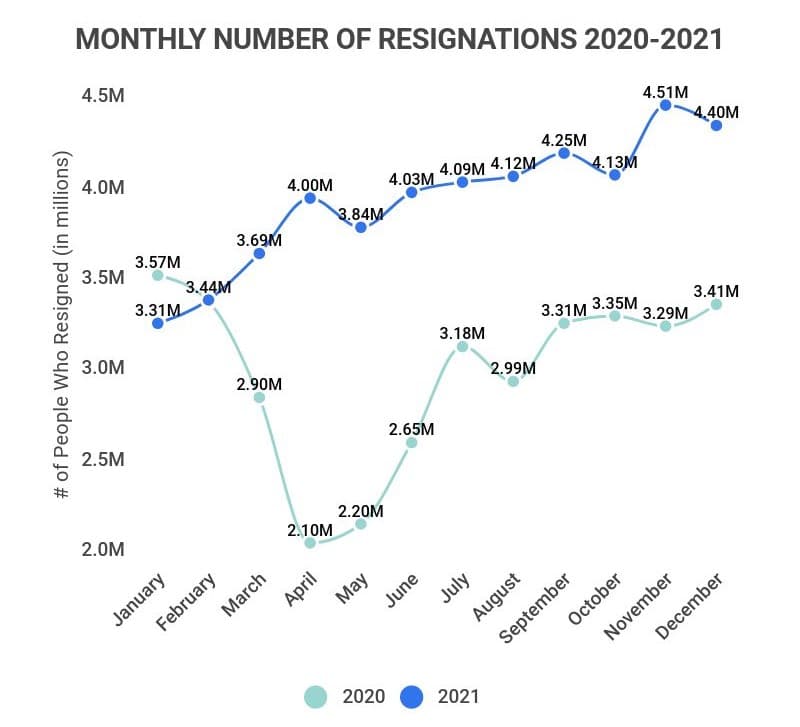
-
From 2019-2021, the monthly quit rate has fluctuated between 2-3%.
Though this might not necessarily seem like a lot, it’s much larger than the 1.2% record low recorded in 2009. In fact, the quit rate was actually still high in 2019, even before the effects of the Pandemic.
-
Comparing the month of November 2021 to November 2012, the number of resignations increased by 125%.
In 2012, there were roughly 2 million people who quit their jobs in November. In 2021, that number effectively doubled to 4.5 million.
-
In the month of January 2022, there were 11.26 million job openings in the U.S.
At the start of January 2021, there were around 7.23 million job openings. However, in only one year, that number has increased by 55.75% to 11.26 million.
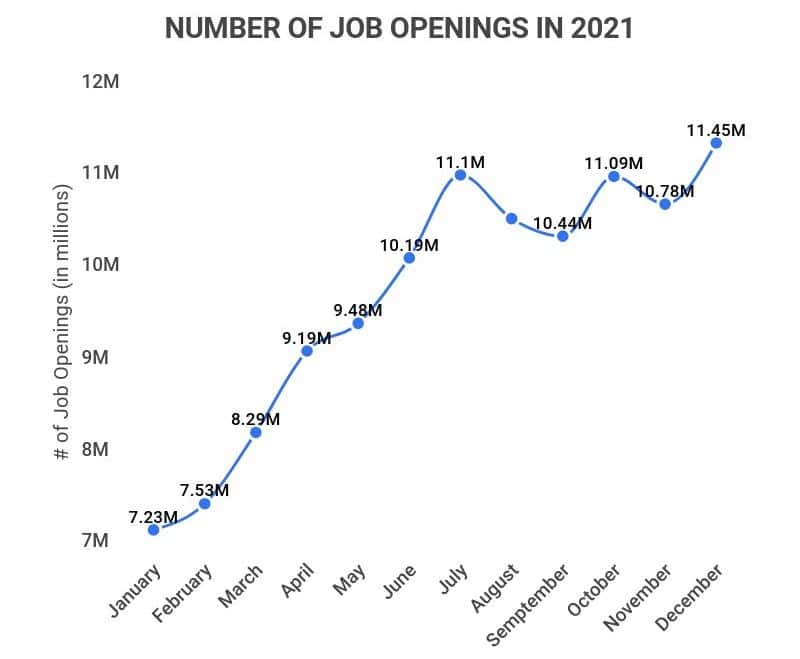
Great resignation statistics by job quitters’ reasons and results
Workers don’t quit their jobs without good reason. After all, many Americans rely on their jobs for health care, retirement savings, and more. Therefore, to find out exactly why Americans are deciding to quit, we’ve gathered the following facts:
-
37% of Americans cite “pay was too low” as a major reason they left their job.
That’s a higher percentage than any other reason and doesn’t account for the 26% of people who also cited it as a minor reason for leaving. Therefore, at least 63% of Americans have left their jobs partially because the pay was too low.
Other common reasons for leaving include No opportunities for advancement (63%), Feeling disrespected at work (57%), Child care issues (48%), Lack of flexibility (45%), and Lack of benefits (43%).
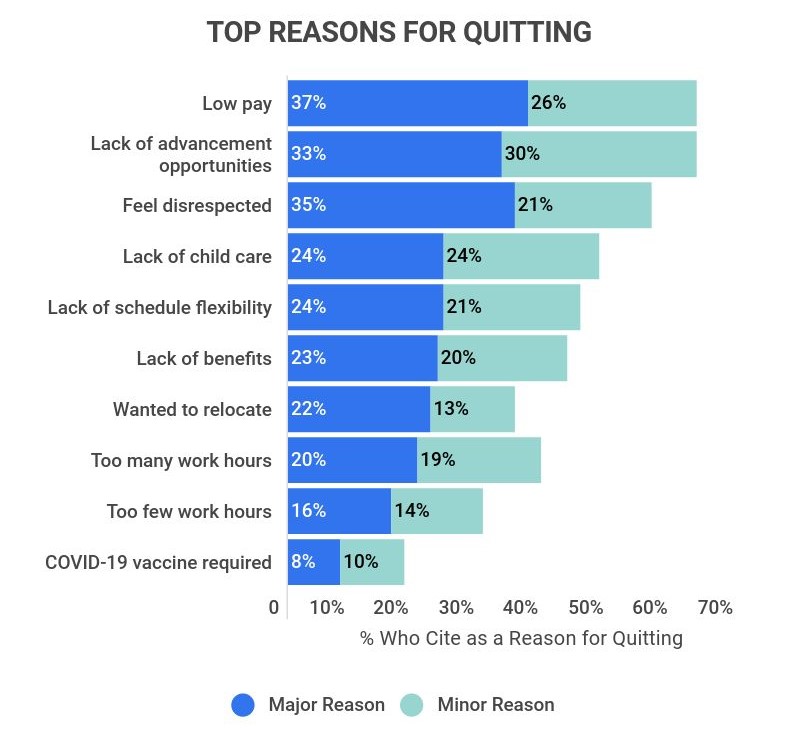
-
18% of workers left their jobs because they didn’t want to take a mandatory COVID-19 vaccine.
Despite this being the least common of the major reasons people have left their jobs, it’s still an interesting commentary on the polarized political reactions to the Pandemic. Many right-leaning individuals have argued that not taking the vaccine is personal liberty and thus decide to leave their jobs when vaccines are mandated.
-
94% of those who quit their jobs in 2021 say it was at least somewhat easy to very easy for them to find a job.
Due to the fact that the number of jobs available between 2021 and 2022 rose by over 55%, it’s unsurprising that so many of those who quit found it easy to find a new job. More specifically, 61% said it was at least somewhat easy, while 33% said it was very easy.
-
Of those who quit their jobs, 55% now have full-time jobs.
While only 23% chose to have part-time jobs because lack of benefits was one of the major issues for many who quit their jobs, many of those same former employees have sought out full-time opportunities.
-
42% of those who left their old job and found a new one in 2021 say their benefits have improved.
While 36% say it’s about the same, and a troubling 23% say their benefits are worse. That means that despite the fact that many employers are in desperate need of new workers, a considerable one in five employees has received worse benefits after changing their job.
Great resignation statistics by job quitter demographics
The Great Resignation has been driven by different demographics. After all, the United States is a highly diverse country, full of different ages, nationalities, and more. With that in mind, here are some insights our research uncovered about the demographics of the Great Resignation:
-
Those with a High School Diploma or less were more likely to quit their job, with 22% quitting.
Generally speaking, the higher an employee’s education level, the less likely they are to quit their job. For instance, 20% of those with some college quit their jobs, 17% of those with Bachelor’s degrees did, and only 13% of Postgraduates did.
-
Those between the ages of 18-29 resigned more than any other demographic, with 37% quitting their jobs in 2021.
The differences between the number of people quitting based on age are rather dramatic, with 17% of those between the ages of 30-49 quitting, 9% of those between 50-64 quitting, and only 5% of those 65+ quitting.
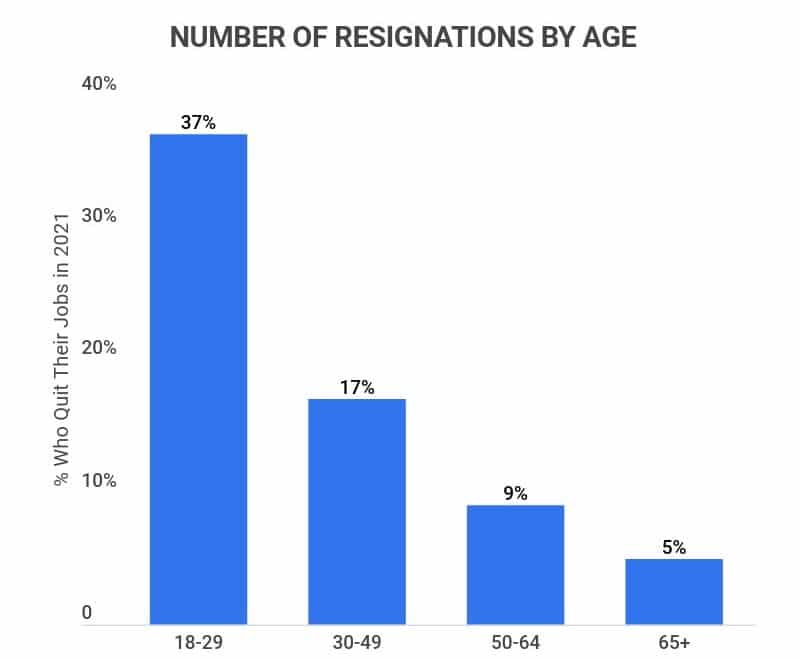
-
Women are 11% more likely to quit than men.
Throughout 2021, women were slightly more likely to quit their jobs than their male counterparts. On the whole, 20% of women quit their jobs, while 18% of men did.
-
Hispanic and Asian people resigned more than any other race, with 24% of each demographic quitting their jobs.
Meanwhile, 18% of Black Americans quit their jobs, and 17% of White Americans did. Compared to other demographics, the race had less of an impact on the number of employees resigning.
-
Those with lower incomes were 2x as likely to quit their jobs when compared to upper-income employees.
24% of those with lower incomes quit their jobs in 2021, compared to 18% of those with middle incomes and only 11% of those with upper incomes. This disparity is perhaps unsurprisingly, given that the top reason cited for wanting to leave a job was not being paid enough.
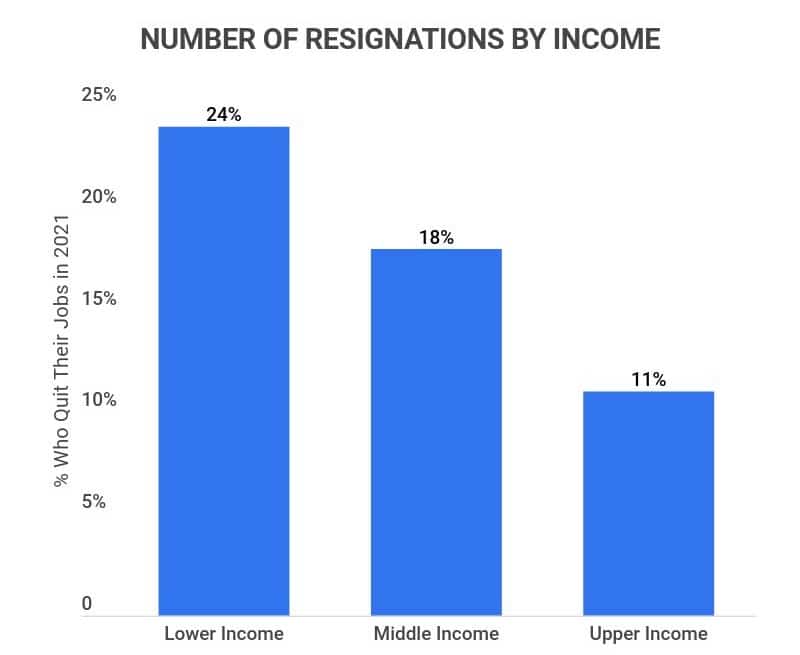
Great resignation statistics FAQ
-
What is causing the Great Resignation?
There are four major causes of the Great Resignation. These include:
-
Job Openings. Many industries, especially those in accommodations, food service, leisure, and hospitality, have seen many new job openings. This is because many jobs that were suspended or lost during 2020 returned in 2021. This gives employees many options for where they want to work.
-
Burnout. For many industries, and especially the healthcare industry, the COVID-19 Pandemic caused massive amounts of burnout and a lack of work-life balance. Ultimately, this resulted in many people wanting to leave their jobs.
-
Remote Work. Many employees realized that they prefer to work remotely, so when companies began requesting that their employees return to in-person work environments, many didn’t want to.
-
Priority Re-evaluation. Being forced to stay home and other changes caused by the Pandemic caused many people to realize they wanted to re-prioritize their life. Many employees ended up feeling like they were overworked, underpaid, and undervalued, causing them to want to switch jobs.
-
-
How significant is the Great Resignation compared to past historical trends in job quits?
The Great Resignation is incredibly significant compared to past historical trends. For example, compared to only ten years ago, in 2011, more than double the number of people are quitting each and every month. In fact, the quit rate per month for 2021 is 115% higher than the monthly quit rate in 2011.
Overall, the past decade or so has been very historic when it comes to job quitting. While 2009 saw some of the lowest rates in history, 2021 has some of the highest rates in history.
-
How long will the Great Resignation last?
The Great Resignation is expected to last through most of 2022. Experts project that while 2021 was the height of the Great Resignation, the same trends will likely continue for most of 2022, even if less dramatic. However, by the third quarter of 2022, the job market is expected to start stabilizing.
Of course, none of this is set in stone, but it does seem as though 2021 was the peak, and things will slowly normalize.
-
Who is impacted by the Great Resignation?
Workers and employers have been impacted by the Great Resignation. First and foremost, the employee demographics most affected by the Great Resignation are those between 18-29 (37% quit their jobs in 2021) and those with lower incomes (24% quit their jobs).
These employees searched for jobs that would pay them more, as well as give them better opportunities and benefits, with about half succeeding.
Meanwhile, employers are also impacted by the Great Resignation. The sheer number of jobs available has caused employers to become very competitive. Many big names like Taco Bell, Walmart, and more, are now paying employees far more than they used to in an attempt to retain them and find new hires.
-
Is the Great Resignation happening globally?
The Great Resignation is somewhat global, but only in certain countries. For example, countries like Germany, Japan, China, and European and Asian countries have all seen similar trends. Interestingly though, there hasn’t been a Great Resignation in Canada, our next-door neighbor.
Overall though, people around the world aren’t just quitting their jobs so much as they’re reshuffling their jobs or careers. Since the start of the Pandemic, many people have re-evaluated their career options.
-
Is 2022 a good time to change jobs?
Yes, 2022 is a good time to change jobs. That’s because there are still more jobs available than normal, and fierce competition in 2021 has led jobs to offer better pay, better benefits, and more. For instance, Taco Bell previously had wages as low as $8 per hour but is now committed to raising wages in all stores to $15 per hour by 2024.
And that’s just one company. The sheer number of jobs available in 2021 has caused the majority of jobs across many industries to improve the quality of their jobs.
-
Will the job market get better in 2022?
The job market is expected to get better in 2022 but still won’t be “normal.” While there were over 10 million jobs that needed to be recovered in 2021, that number has been more than halved to 4 million in 2022. That means that while trends set by the Great Resignation will likely continue through 2022, things won’t be as intense.
Further, it’s possible that the job market will be almost normalized by the third quarter of the year, as the number of jobs available will return to a more traditional amount.
-
How many people quit their jobs in 2021?
47 million Americans left their jobs in 2021. With an average of 3.98 million leaving their jobs every single month, peaking in November when 4.5 million people quit. For context, this all means that 23.5% of the total U.S. workforce resigned from their jobs in 2021.
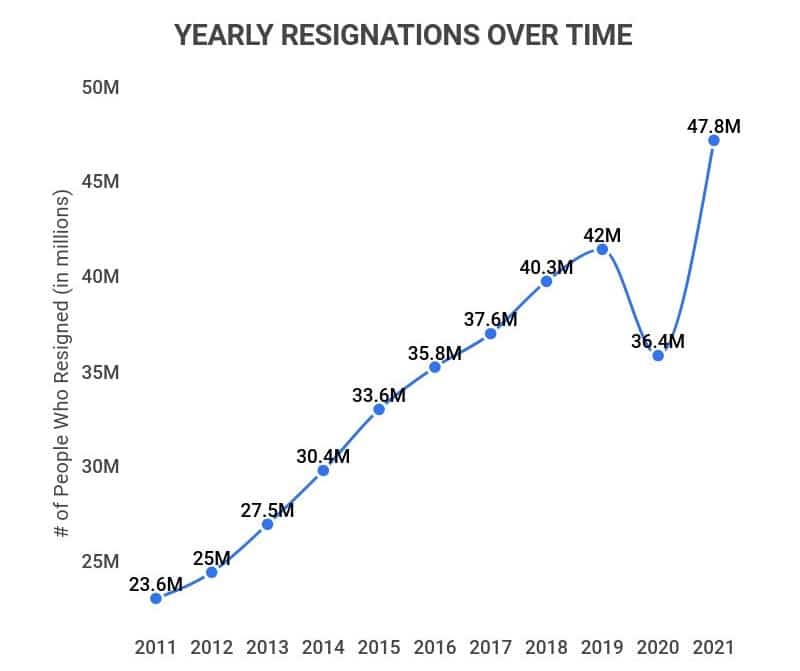
Conclusion
With over 47 million people resigning from their jobs in 2021, the Great Resignation is a historical trend that will have an impact on the job market for years to come. Many workers are not only changing jobs but also their entire careers. Plus, not only has this caused shifts in where people work but also where they live and how they choose to create a work-life balance.
Overall, the Great Resignation is causing the job market to become more competitive and more remote. As of 2022, jobs are offering higher wages, better hours, improved benefits, and more work-from-home opportunities. Therefore, while the Great Resignation may be putting major companies in a bit of an employment pickle, it’s ultimately causing them to improve.
Sources:
-
CNBC. “The Great Resignation is still in full swing. Here’s what to know.” Accessed on April 3rd, 2022.
-
The Conversation. “The ‘great resignation’: Historical data and a deeper analysis show it’s not as great as screaming headlines suggest.” Accessed on April 3rd, 2022.
-
Smartest Dollar. “U.S. Industries Where the Most Workers Are Quitting Their Jobs [2021 Edition].” Accessed on April 3rd, 2022.
-
SHRM. “Interactive Chart: How Historic Has the Great Resignation Been?” Accessed on April 3rd, 2022.
-
Pew Research Center. “Majority of workers who quit a job in 2021 cite low pay, no opportunities for advancement, feeling disrespected.” Accessed on April 4th, 2022.
-
Pew Research Center. “Monthly job openings in the United States from January 2021 to January 2022.” Accessed on April 4th, 2022.






